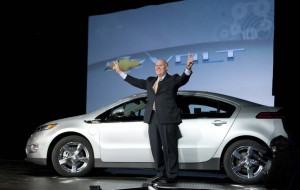The auto industry has given the U.S. economy a major lift in recent months, GM chairman and chief executive officer Dan Akerson told new graduates of the Columbia University’s business school.
That’s a big shift from just a few years ago, when it was one of the forces of economic decline. And Akerson’s speech clearly was aimed at convincing the best-and-brightest of the school’s students that they should be taking a closer look at Detroit as they begin their promising careers.
“The auto industry has gone from being an anchor on the economy to being the wind in its sails… in fact, we’re one of the few bright spots,” said Akerson, who joined GM after it emerged from its 2009 bankruptcy. “We’re adding jobs and investing in America, just as America invested in us.”
Since mid-2009, GM has announced investments of more than $7.1 billion in 30 U.S. facilities and created or retained nearly 18,000 American jobs, the executive noted
“No one, not even the most enthusiastic supporters, predicted this three years ago: The auto industry is adding jobs and driving the economy again,” Akerson said. “And that’s because two very different Administrations both had the wisdom to understand how important the auto industry is to our economy, and had the courage to act.
“Consider these facts, which apply to the auto industry as a whole here in America; 8 million total employees are involved; there are 3.1 million total jobs in this country dependent on automakers and another 3.3 million total jobs are dependent on suppliers to the auto industry and another 1.5 million total jobs are dependent on dealers.
Akerson said the auto industry now accounts for 1 in 17 private-sector jobs and those jobs create $500 billion total compensation annually. They generate $70 billion in personal tax revenues annually, which represent 3.0 to 3.5% of this country’s gross domestic product.
In addition, 47 different states have at least 10,000 auto-related jobs and in 20 states that jumps to 100,000 or more.
“Today, the industry is humming, producing outstanding vehicles in increasing numbers,” said Akerson, a former naval officer who spent most of his career in the telecomm industry.
The industry sold 12.5 million new vehicles in the U.S. in 2011, which is a 10% increase over 2010 sales, the executive noted. And sales are surging faster than most observers had expected, demand now likely to push into the low to mid-14 million range for all of 2012.
“That’s why this industry is so important. And that’s why it was worth saving – again, thanks to two different administrations,” said Akerson. “Their actions allowed the industry to move forward. Their actions showed real leadership. We need more of that. We need people who are well-educated, talented and motivated,” Akerson said.
The message had a double purpose. In recent years, the auto industry has lost the allure that once brought it some of America’s best-and-brightest. Executives like Akerson are now pressing the rebuild the industry’s image to draw the best talent from colleges and universities, rather than losing them to the banking or high-tech worlds.

